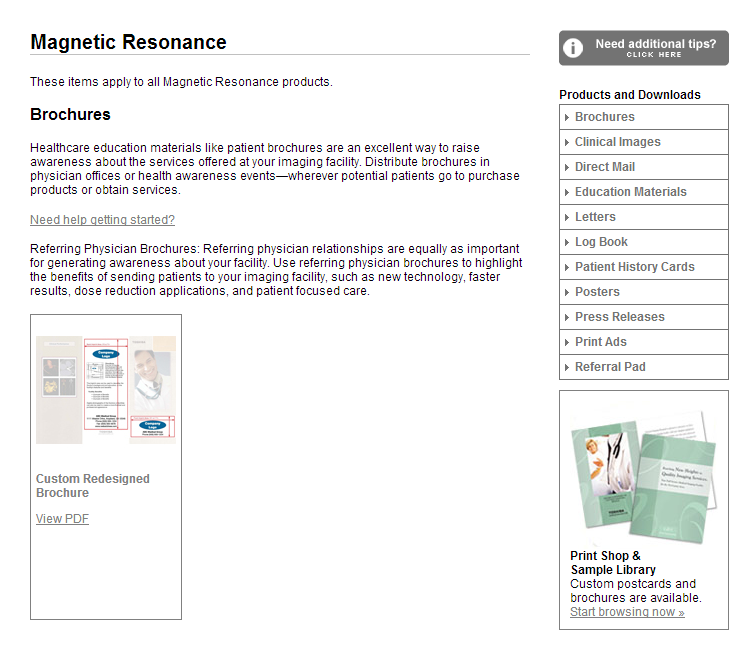How Toshiba Medical Provides Marketing Resources for Its Customers
When your customer uses your product to sell a service, helping that customer sell their service provides both a co-marketing opportunity and a way to offer an additional level of customer service.
Toshiba America Medical Systems’ customers are medical imaging centers buying large medical devices such as MRI, CT and ultrasound scanners, and use those products to provide medical services.
Toshiba combines a co-marketing opportunity with a customer service element through Image Maker, an online portal. With this program, the team provides Toshiba Medical customers with some basic marketing advice along with a wide range of marketing materials – brochures, press releases, videos and more – for each of the company’s main product areas:
- Cardiovascular x-ray

- Computed tomography
- Magnetic resonance
- Ultrasound
- X-ray
These products are expensive, ranging from $50,000 for an ultrasound system to more than $1 million for a MR scanner.
I had the opportunity to interview Catherine Wolfe, Senior Director of Corporate and Strategic Communications, Toshiba America Medical Systems, for more details about the Image Maker portal.
Why create this online resource for marketing materials?
Catherine said Image Maker was created for two basic reasons – increase customer satisfaction, and brand building as a co-marketing program.
“The issue for our customers is how can they get information that helps them differentiate themselves in their particular market about the equipment and the benefits that it provides,” Catherine explained.
She added, “The other issue for us is how can we build our brand to the greatest extent possible, and by providing this added support to our customers, we are able to get our message out there to a much greater extent than we would otherwise be able to.”
Who is the marketing material for?
The marketing material found on the Image Maker is extensive enough a Toshiba Medical customer with limited staff or time could easily pull the creative pieces, review some marketing advice and execute campaigns.
At the same time, Catherine said many of Toshiba Medical’s customers do have marketing staff and the material helps those marketers with ready-made art and messaging.
The online resource also alleviates a particular pain point for marketers in the healthcare industry.
Catherine explained, “The healthcare industry overall— it’s more difficult. Costs are being constrained more and more. Marketing tends to be one of those budgets that gets cut, so we are able to step in and help folks that may have experienced that.”
Beyond the actual materials and other online resources, the marketing team at Toshiba Medical has a dedicated staff member who provides support directly to its customers with marketing recommendations based on other customer’s experiences on meeting various marketing challenges.
What is in the resource center?
Catherine outlined some of different types of marketing content in the Image Maker portal:
- The most basic includes press releases or letters for referring physicians to help with local marketing
- Radio spots
- Videos for embedding on websites or even for broadcast advertising
- Brochures and promotional material

She added the brochures have areas where the marketer can customize the material by adding their own branding and information.
How is the resource center offered to customers?
Toshiba Medical customers have two options for accessing the Image Maker portal. The first option is a basic package that comes at no cost. A second package comes with an upfront investment, but includes “Image Maker dollars,” which can be used to reimburse marketing expenses.
Catherine explained a customer purchasing the more extensive package would get, for instance, $5,000 worth of advertising. When that customer had marketing materials printed, Toshiba Medical would reimburse that expense up to the amount of the customer’s Image Maker dollars.
A dedicated employee is available to assist customers who choose either of the two options.
Keeping the program relevant
Toshiba Medical has what Catherine described as an “extensive customer satisfaction program” based around a series of interviews with customers to learn how the company is performing in terms of meeting expectations and providing support.
Several years ago, Toshiba conducted a survey to discover specifically what its customers needed in terms of vendor support on the marketing side. The survey included very specific questions to help the team meet the exact needs of Toshiba’s customers.
She added the program evolves based on changing communication channels. For example, as website marketing becomes a greater concern for Toshiba customers, the Image Maker portal now offers more electronic material.
Specific messaging on marketing materials is based on medical trends and concerns.
“A couple of years ago, there was this focus on radiation dose and concern over dose,” Catherine stated. “So, we put together a range of materials that helped our customers talk to their patients [on these issues].”
How does the program benefit Toshiba Medical?
A marketing effort of this nature is difficult to quantify, and the team really doesn’t track any key performance indicators aside from continuing to adapt to questions and suggestions on specific marketing pieces coming from the customers using Image Maker.
Catherine said there are around 1,000 active users of Image Maker – what she describes as a relatively small percentage of the company’s installed customer base – and averaging around 100 new users each year.
Because these are expensive products with a complex sales process and with a replacement cycle of five to seven years, one major benefit of offering these materials and this level of marketing support for customers is brand awareness.
One, the customer satisfaction aspect keeps the brand in the mind of the current customer. Two, when those customers use the provided market material, there is a co-marketing aspect helping extend the brand awareness reach of the marketing team.
Catherine stated, “The takeaway for us is our customers are going to reach out and request [marketing materials] anyway. If we invest in this upfront and make sure we have a thought-out program with materials that we spent time on and feel confident that they meet our customers’ needs, we feel like we have a win with it and differentiate ourselves in the way that we want to differentiate ourselves in the market.”
Summing the Image Maker program up, Catherine said, “Our intention is to be the best in the industry when it comes to customer satisfaction, so this is another example of how we make sure that we are.”
Related Resources:
How to Mine Your Customer Service Department for Nuggets of Marketing Gold
What is B2B?: Discovering what the customer wants by understanding your Buyer’s Funnel
Customer-centric Marketing: 7 triggers to engage customers and build loyalty
Categories: Marketing B2B marketing, co-marketing, content marketing









